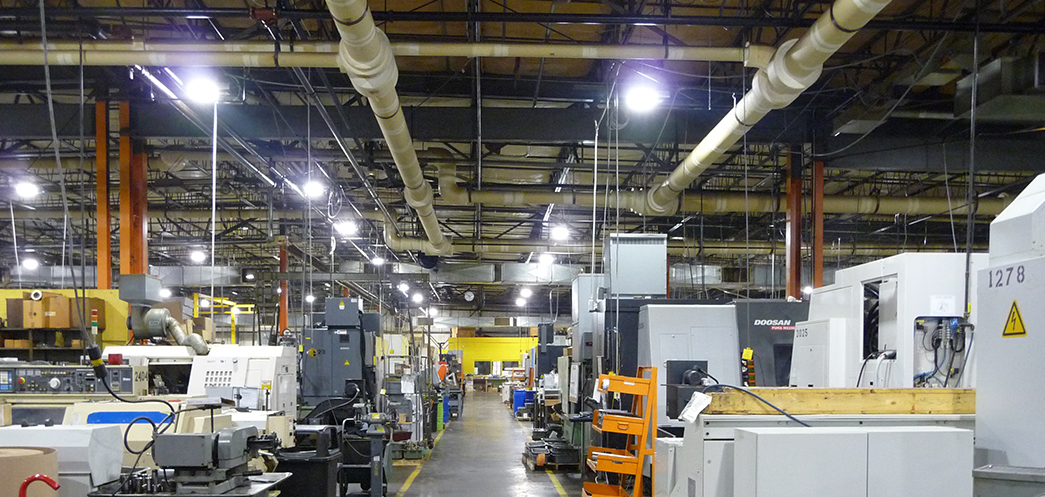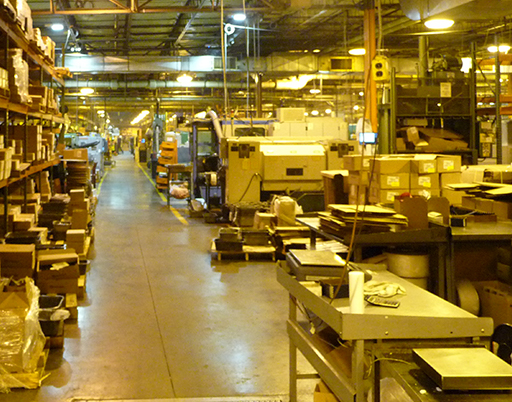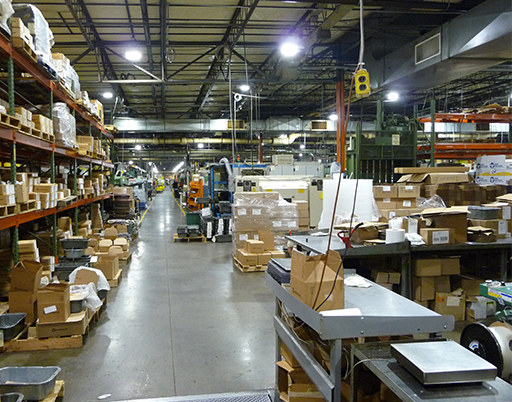Customer: Creed Monarch
Location: New Britain, CT
Facility Size: 140,000 ft2
Operational Schedule: Up to 12 x 6
Environment: Manufacturing
Temperature Range: Up to 100ºF at roof
Installation: Retrofit
Savings: 90% lighting
Previous Solution: 400 W High-Pressure Sodium (HPS)
Reseller: Energy Services Group
Intelligent Lighting System in Contract Manufacturing Facility Expected to save 1,036,669 kWh Annually
Established in 1953 and located in New Britain, Connecticut, Creed Monarch specializes in the contract manufacturing of precision machined ferrous and non-ferrous alloy components. To serve a diversified account base with customers in industries ranging from automotive and aerospace to munitions and hardware, Creed Monarch operates a 140,000-square foot manufacturing facility that employs more than 260 people, with sales in excess of $42 million in 2010.
As a premier provider of precision machined components, including both single piece and high-volume, automated parts production, Creed Monarch’s management team is committed to staying at the forefront of its industry — a philosophy that extends to all aspects of its business. So when it came to replacing the lighting within its manufacturing facility, the management team decided they would wait until they found the ideal lighting solution — one that met a rigorous set of energy efficiency, light quality and sustainability criteria defined as must-haves.
- Before
- AFter
Lighting Criteria Drives the Process
in high-efficiency replacement lighting for industrial businesses, the management team at Creed Monarch spent more than 10 years searching for a lighting solution that met all of their criteria. They finally found that solution with the Intelligent LED Lighting System from Digital Lumens.
“Over the years, we’ve looked at many alternatives for our facility, none of which met all of the criteria we deemed critical to moving forward with a new lighting investment,” said Paul Stawarz, Facility Manager for Creed Monarch. “Time and again, two essential ingredients were missing: integrated sensors and centralized control. As machinery is brought on- and off-line to fill customer orders, we knew we would leave significant savings on the table if we could not manage lighting behaviors individually, by zone or facility-wide. Digital Lumens does just that as part of a comprehensive system that can be continuously tuned to meet our shop floor requirements.”
More than just a one-for-one replacement for their 400-watt high-pressure sodium (HPS) lighting, the Intelligent Lighting System delivered on the team’s vision of a future where lighting is an easily managed asset that can be controlled all the way down to the individual luminaire level. In fact, the Digital Lumens system is now providing Creed Monarch with:
- Massive energy savings. Currently in the 75% range and projected to reach up to 90% within the first year as the management team continues to fine tune lighting delivery. With projected energy savings of 1,036,669 kWh annually, or $108,436 at $0.1046 per kWh, the company is on-track to secure a rapid payback, while maximizing Connecticut Light & Power utility rebates and energy efficiency incentives.
- Facility-wide, zone- and luminaire-level control over lighting. With occupancy sensors and wireless networking integrated into every luminaire, the management team has complete, centralized control over how lighting is used within its facility and the flexibility needed to match specific lighting needs to the constantly changing nature of the work associated with contract manufacturing.
- Higher, better quality lighting and illumination levels. Before and after pictures clearly illustrate dramatically improved light levels and the benefits of the Digital Lumens high color rendering index (CRI) LEDs at Creed Monarch. Within this large, highly concentrated manufacturing space, colors are sharper; aisles and machinery are well lighted, and light levels are higher around the operating surfaces central to the machinists’ work.
- Instantaneous on, off or dimming without impacting luminaire longevity or lamp life. With HPS or fluorescent lighting, every time a luminaire is turned on or off, it reduces both luminaire longevity and lamp life. Furthermore, off isn’t really off, as these luminaires continue to consume electricity even in an off state. With the Digital Lumens system, off really means off; dim means whatever level of dimming management defines; and, when an occupancy sensor is triggered, lighting instantaneously returns to full on, enabling management to comfortably and safely eliminate unused lighting to save energy.
- Maintenance-free lighting well-suited to a rugged industrial environment. With independent lab-rated lifetimes in excess of 50,000-hours without re-lamping or re-ballasting, the Digital Lumens LED-based lighting eliminates maintenance costs associated with HPS lighting (or any fluorescent alternative).
Up to The Challenge
Creed Monarch operates on a ten- to twelve-hour schedule five days a week, with Saturdays often required to catch up to high order volumes. Daily work activity centers on the machines, or cells, required to complete specific customer orders. This means that at any given time, individual workstations, groups of machines, aisles or storage spaces are frequently unoccupied, providing opportunities to dim or turn off individual or groups of lights to maximize energy savings.
Using the Intelligent Lighting System’s integrated LightRules lighting management software, Creed Monarch is now able to fine tune its lighting to match these work patterns while safely eliminating unused light. This level of flexibility enables them to:
- Group luminaires around specific clusters of machines used to complete specific tasks, and control their settings and behaviors. As management learns more about how lighting is used (now that they no longer are locked into 100% on luminaires) they are slowly altering timeout and dimming settings to maximize light use and savings.
- Re-group lighting to account for unexpected (at time of installation) needs or changing business conditions (new machines or changed floor plans).
- Isolate, at will, any single luminaire (e.g., over a specific machine or main entryway) and have it behave differently from the lighting around it.
- Dim lighting in aisles surrounding machinery by 40% and in less traveled aisles by 20%, knowing that they can increase or decrease these settings at any time through LightRules, without ever having to touch a light luminaire.
- Have lighting behave differently depending on the time of day (e.g., night cleaning versus production shifts); week or weekend; or to account for holiday schedules.
- Learn more about how lighting is being used, such as where activity is concentrated in the facility or when peak usage occurs, through integrated reports that document lighting use and energy savings.
- And finally, know that if the lights are dimmed or programmed to shut off as per the schedule entered, the occupancy sensor will instantly turn on the light if presence is detected, assuring worker safety

While the Creed Monarch team considered fluorescent alternatives with add-on sensors, they lacked the level of flexibility management required. Additionally, the management team was adamantly against any solution that would force them to lock-in luminaire settings at installation (or hire lighting engineers to physically change luminaire/sensor settings post-installation) or restricted timeout settings to a limited number of pre-defined intervals.
Alternatively, they liked the fact that the Intelligent Lighting System’s sensors were not a bolted-on afterthought, but rather an integral part of system designed for durability, flexibility, light quality and energy savings. According to Mr. Stawarz, “You cannot save more than off, but you need the tools necessary to intelligently — and safely — turn lighting off when it is not needed. That is what the Digital Lumens system provides Creed Monarch.”
“The decision to upgrade our lighting was really a ten-year process. We saw countless proposals and new technologies through the years, but Digital Lumens was the first to address our need for control of individual luminaires,” said Richard Creed, President of Creed Monarch. “Digital Lumens provided the only lights with controls and sensing that were two generations ahead of anything we saw. We are able to dim, shut off and customize light levels without affecting the life or performance of the light. We want to see Digital Lumens succeed with us, and we are looking at this as a long-term relationship.”



